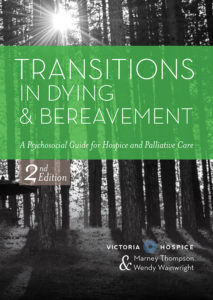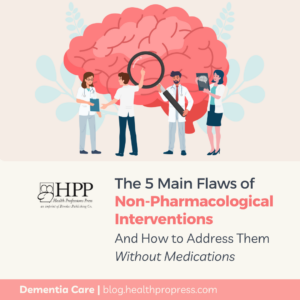
In My Own Voice: Pre-death Restlessness
November is National Hospice and Palliative Care Month, and HPP will be joining organizations across the nation to raise awareness for hospice and demonstrate its importance. In our Hospice Perspectives Series, people share their stories of hospice care. While these stories do feature death, they also feature profound hope, compassion, comfort, and joy. They will touch your heart and provide invaluable insight into palliative care and the end of life.
This perspective is written by Eve Joseph, M.A., a longtime hospice counselor and hospital social worker. She is also an acclaimed poet.
“So, you are the one who is going to tell me what death is like…”
I came into the unit one evening, and the nurse said to me, “There is a man who wants to know what it’s like to die, so I told him you would come and talk to him.” This patient was in and out of consciousness. When he was awake, he was agitated and worried. When I went in, he said, “So, you are the one who is going to tell me what death is like.” “No,” I replied, “you are going to tell me.” He spoke about being afraid of judgment after he died. He hadn’t been good enough as a father, a husband, a son, a friend, he said. He was aware of being deeply flawed, as we all are. “Death is there, by the dresser,” he said, “and has been there for three nights.”
I don’t know if he really added “and we will sleep together tonight” or if that is a trick of my memory. His restlessness wasn’t fear but something else deep—some need for confession and to let something go. Pre-death restlessness, I think that this is a good term, from a counselor’s perspective. It is the work of dying, or at least a big piece of the work. The term delirium puts the experience in the mind and in the body, but I see this as spiritual work. We cannot discount the spiritual work that is happening here.
Dying people are learning how to go…
We want to think that death is natural and peaceful and beautiful but that’s not all it is. There is struggle and work in dying. It’s a process, such as birth. The dying are learning how to do this. It is a struggle to get out of this world, to let go of the ties, the things not done. What I see and hear family members say is that, within pre-death restlessness, they recognize times when the patient is there and times when he or she is not. My own belief about this is that the spirit goes by increments. Dying people go for a bit and come back, and in this way, they are learning how to go, how to die. We watch with eyes of the living. We don’t know, can’t know, and can’t enter the experience of dying people. They are doing something we can’t do.
This is as much as I can understand—people who are dying are separate from us and we have to let them go. This is a necessary split or rift. It is not peaceful or joyful. This is enormously difficult for families. The struggle to go looks like suffering, agitation, fear, or anxiety, and the families can’t do anything. They feel powerless and helpless. And family members must learn how to stay as the person who is dying learns how to go.
I think that there are some things that we can do as counselors.
A transition from living to dying
First, we can explore what we believe about this. We can get clear in ourselves. Then, we can help family members see another possibility for understanding what is happening. We can offer that this is the work of death and dying as opposed to terrible suffering. This doesn’t mean we don’t treat pre-death restlessness. Treatments and medications, are very important. But offering family members language with which to understand what they see allows them to be there in a different way and to find other things to be done in response to it.
Pre-death restlessness forces a transition from living to dying. The patient has turned somewhere else and, often, families know that to be true. They can accept that there is enormous value and purpose in this transition. Counselors become translators, not as experts but as people who have seen this before. With enormous caution, we can share our beliefs and the possibility of something else, which is only a possibility.
Discover a language when there is no language
We can discover a language when there is no language—not to impose a language but to help people come to their own language and understanding of what they see. Pre-death restlessness is a hard place for counselors. When I am with a mother who is restless and agitated and trying to get up and I see her adult children’s pain, I feel anxious, too, and I want her to be peaceful, I want her to be medicated. Even while I am frightened, anxious, powerless, and all of those things, the least I can do is stand with the patient.
There is value in being calm and holding space for other possibilities and for understanding in the midst of confusion, distress, and chaos. It would be a disservice if I could take away people’s suffering. The sacred is not pretty, it is bloody in moments. And our work is to stand in it, stripped to our essential humanness.
This is what we offer—all our humanity—our fear, our hope, our caring, our frailty. We are not separate; we are the same; and we are here. This is what we offer.
Excerpted from Transitions in Dying and Bereavement: A Psychosocial Guide for Hospice and Palliative Care, Second Edition by Victoria Hospice, Marney Thompson, and Wendy Wainwright © 2017 by Victoria Hospice. All rights reserved.
Read the book!
 Transitions in Dying and Bereavement
Transitions in Dying and Bereavement
A Psychosocial Guide to Hospice and Palliative Care
Second Edition
By Victoria Hospice, Marney Thompson, M.A., and Wendy Wainwright, M.Ed.
Copyright © 2017 by Victoria Hospice. All rights reserved.
Help guide patients and families through difficult end-of-life experiences with this compassionate, strengths-based approach from a team of expert counselors.





Add comment